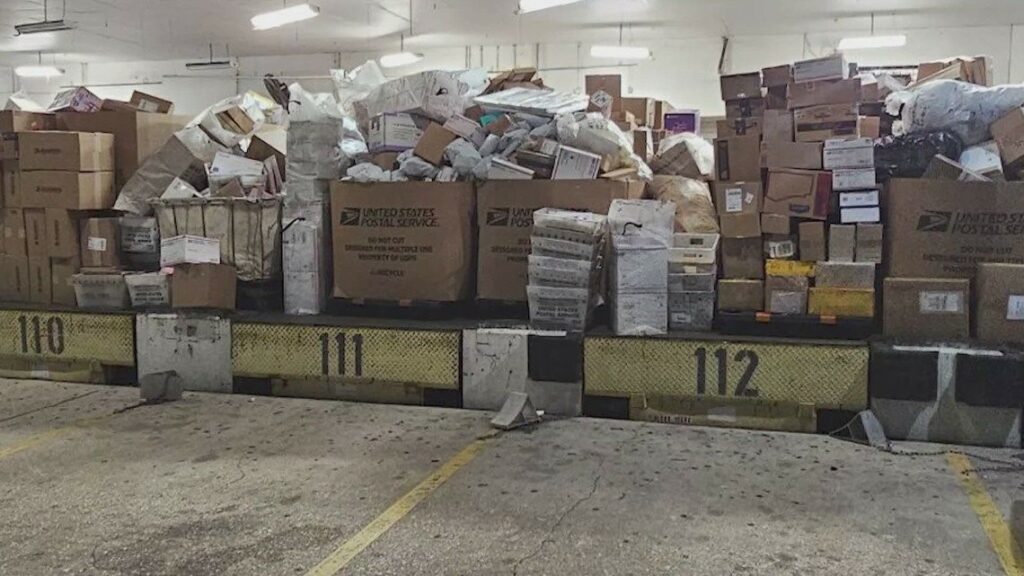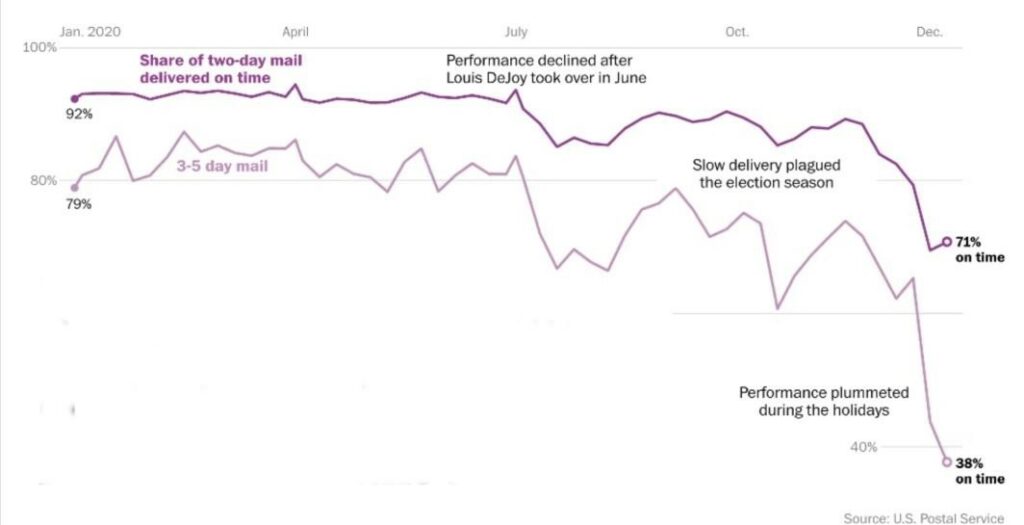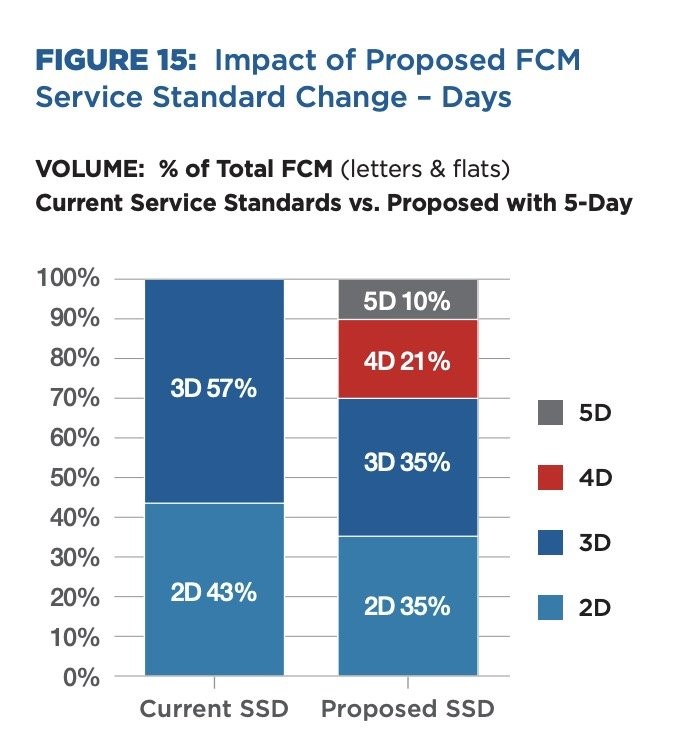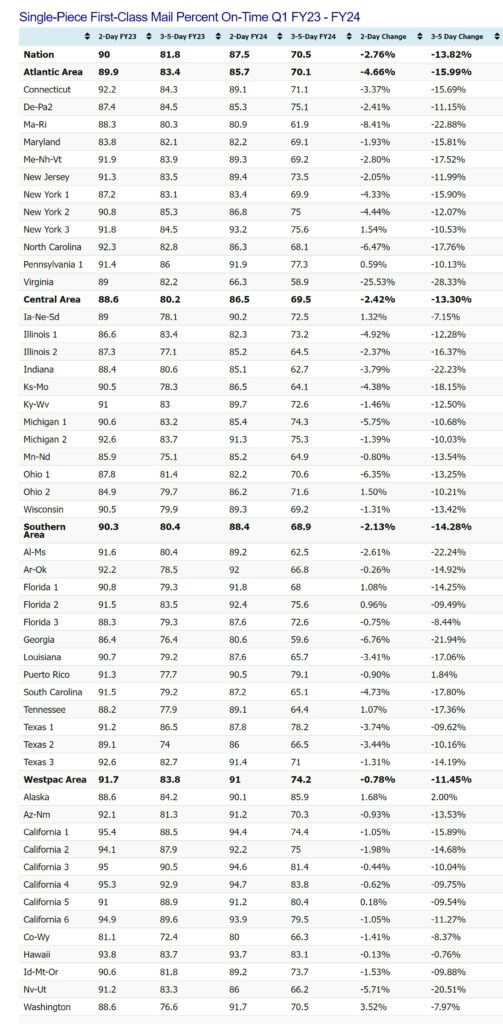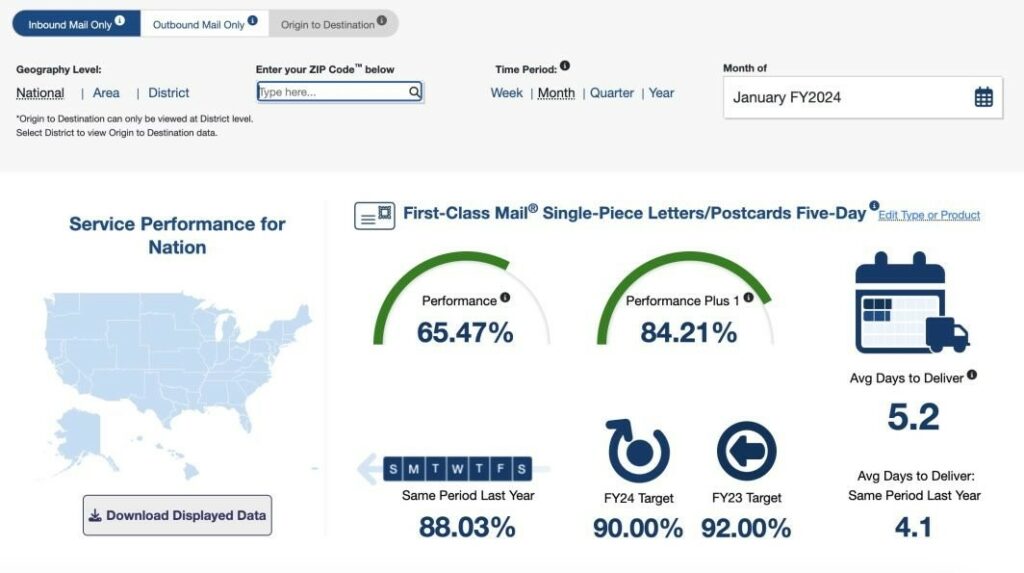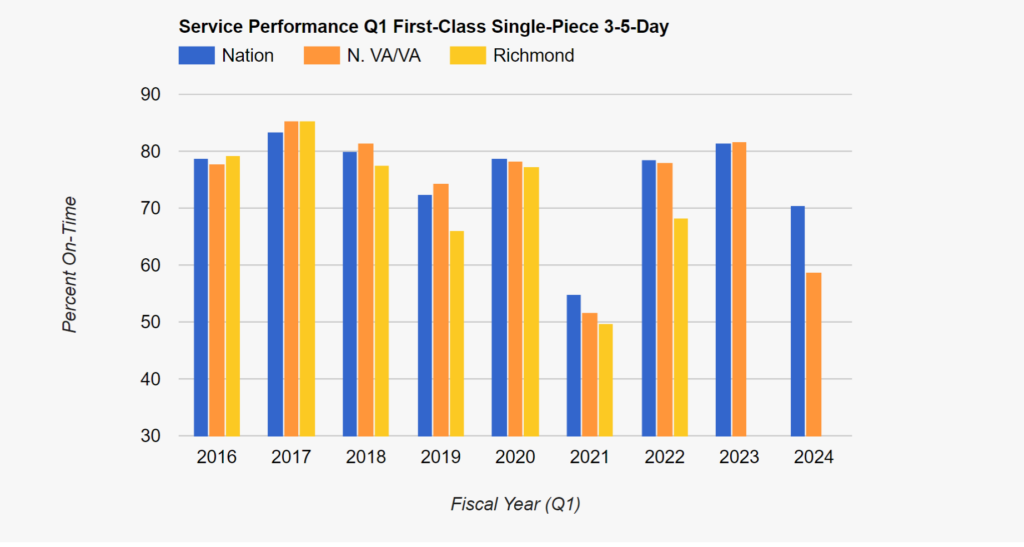The mail slows down, again
A pretty damning report detailing Louis DeJoy’s failure and his program’s failure to replicate mail delivery or improve mail delivery which was the goal.
by Steve Hutkins
Save The Post Office
As you have probably noticed from personal experience and reading the news, the Postal Service is having a difficult time delivering on time. Mail and packages are delayed for days, even weeks, sometimes never arriving at all. For its part, postal management often seems unresponsive to complaints, and they have even refused to participate in town meetings with elected officials to discuss the problems.
Admittedly, not all the mail is slowing down. During the first quarter of FY 2024 (Oct. 1 – Dec. 31, 2023), Marketing Mail had an excellent on-time score of 93.7 percent. But First Class mail is not doing so well.
TV station KHOU says it’s heard from “tens of thousands of people in the Houston area” about their mail being lost or delayed, overwhelming its news tip email. A report in the Virginia Mercury says the late and missing mail in the Richmond area includes jury notices, contributions to a nonprofit museum, electoral ballots, utility bills, tax documents, medications, and testing samples used to screen veterans for colon cancer (rendered unusable by the delays).
While the log jams will eventually be cleared, the problems are not going away anytime soon, and in many respects, slower mail is simply a feature of the postal system being implemented by DeJoy’s Delivering for America plan. In other words, “get used to it.”
The mail slows down, again and again and again
This is the fourth time the mail has slowed down since DeJoy became Postmaster General.
The first slowdown occurred in the summer of 2020, weeks after DeJoy’s tenure began, when the Postal Service initiated a work hour reduction plan to cut overtime and reduce late and extra trips for the trucks going between facilities. Graph Source: USPS and Washington Post, Click to Enlarge Graph.
By the second week of August, on-time delivery of First-Class mail nationwide had fallen nearly 10 percentage points, and scores for single-piece First Class mail with a service standard of 3 days were down 20 percent compared to the same period the previous year.
As the November election approached and voting-by-mail became an issue, leading to several lawsuits against the Postal Service, service performance struggled to return to the pre-DeJoy averages. Then in mid-November, performance scores dropped even more precipitously, due largely to employee absenteeism and the package surge caused by the pandemic. For the week ending Dec. 26, 2020, only 33 percent of 3-day single-piece First Class mail was delivered on time.
The third time the mail slowed was on October 1, 2021, when the Postal Service changed its service standards — one of the first steps in the Delivery for America plan. About 40 percent of First Class mail slowed down, and 30 percent of the 3-day mail was turned into 4-day and 5-day, which allowed the Postal Service to cut costs by switching from air transportation to ground for long-distance mail.
Bar Chart Source: Delivering for America.
The next big step of DFA was consolidating the processing and delivery network, and now that’s slowing down the mail yet again. Over the past several weeks, the roll-out of Regional Processing & Distribution Centers (RPDCs) has been contributing to delays across the country. Two of the regions where there have been the most consumer complaints are Houston and Richmond, where RPDCs were launched last year.
In Houston, mail and packages have been backed up for weeks in the North Houston RPDC and the P&DC in Missouri City, apparently because there were problems installing a huge new package sorting machine in the RPDC. In Virginia, the problems have reached a crisis level, again at least partly due to issues launching a new RPDC at the Sandston P&DC.
Over the coming months, other elements of the DFA plan will slow down the mail even more. Many P&DCs are being downgraded to Local Processing Centers (LPCs) that handle only incoming mail, so local mail will need to be transported to an RPDC for processing, and then sent back to the LPC. That will lengthen delivery times by at least a day.
The Postal Service has also launched an initiative called Local Transportation Optimization, which will eliminate the evening collection of mail at most rural post offices over the next few months, so mail and packages will need to wait until the next morning for collection. That too will add a day to delivery times.
Invitation declined
Elected officials in Texas, Virginia, and across the country have been asking the Postal Service for answers. Congressman Al Green, who represents the Houston area, is calling for more transparency and a Congressional hearing. Virginia’s Senators Mark Warner and Tim Kaine have been pressing the Postal Service to address the “alarming delays,” and they, along with several other elected officials, asked the USPS to attend a town hall about the issues.
The Postal Service “respectfully declined,” explaining that “significant attention and resources have been devoted to monitoring service performance and to providing customer service. Experience has proven that extraordinary or one-off customer outreach events complicate these efforts, rarely provide any meaningful insights to improve operations, and raise questions about basic fairness. Instead, the Postal Service relies on a robust program to collect, analyze, and act on service performance issues and customer complaints and questions.”
As part of this program, the Postal Service maintains a helpful service performance dashboard (as required by the Postal Reform Act) and provides quarterly service performance reports to the Postal Regulatory Commission. It also posts some of these reports on its website. The reports don’t encompass packages — that information is considered commercially sensitive and kept confidential — but they do include First Class mail.
Last week the Postal Service submitted its performance reports for the first quarter of FY 2024 (the last three months of 2023). The reports show that the mail is in fact getting much slower nationwide and in almost every district. They also show that the delays in Virginia are among the worst in the country.
Percent on time
The following table shows the on-time performance scores for single-piece First Class mail during the first quarter of FY 2024 and for the same quarter in FY 2023.
The table merges data in the performance reports for Q1 FY2024 shared with the PRC last week, which can be found on the PRC website here, and the reports for Q1 FY2023, which are here. For easy access, all the reports used in this post are on Google Docs here. The table can be sorted by columns; to revert to the original order, refresh your browser.
Nationwide and district-by-district, the scores are significantly lower than they were last year during the first quarter. For mail with a 2-day service standard, 40 districts were slower, and for 3-5 day mail (a composite for mail with a 3, 4 or 5 day service standard), all but two districts had slower mail than last year. For the 3-5-day mail, the national average dropped from 81.8 percent on-time to just 70.5 percent.
Single-Piece 5-Day First Class Mail In January 2024 (Service Performance Dasboard) chart.
The Postal Service’s service performance dashboard provides the weekly scores for the first few weeks of the second quarter, and it doesn’t appear things are getting any better. For the 3-5-day mail during January, the national average dropped to 68 percent on time. That’s over 20 percentage points lower than last January. (The dashboard doesn’t provide a composite for 3, 4, and 5 day, so that’s an estimate based on the individual scores.)
It’s worth remembering that when the Postal Service relaxed service standards in 2021, it said that changing some mail with a 3-day standard to 4-day and 5-day would enable it to reach an on-time score of 95 percent. Even though the mail would be slower, claimed the Postal Service, it would be more “reliable.” That seemed dubious at the time — 3-5 day mail was averaging a score of about 80 percent — but the Postal Service stuck by the claim, even as it was questioned by the PRC and postal advocate Douglas Carlson during the advisory opinion process.
The scores for the four months of FY 2024 aren’t even close to achieving that goal. Raising the scores for 3-5-day mail from 70 percent to 95 percent is looking more and more like a pipe dream.
Average Delivery Time
Average delivery time (days to deliver) is another metric used to analyze service performance. The Postal Service has been using the composite average in press releases for a couple of years now, typically touting that all mail and packages have been delivered in around 2.5 days, which sounds pretty fast. Last June, in fact, it was just 2.4 days.
The number in the press releases is a composite that includes pre-sort and single-piece First Class, Marketing Mail, Priority, ground packages, and so on. It doesn’t reveal the problems with single-piece First Class mail, the kind of mail sent by individuals and small businesses.
Average delivery time for this composite has been increasing, and during the first quarter of FY 2024, as well as the first four weeks of the second quarter, it reached 2.8 days. That’s about 17 percent more than it was in June.
For First Class, the average delivery times nationwide for Q1 FY24 were just a bit above the service standards of 2, 3, 4 and 5 days (i.e., 2.1, 3.1, 4.2, and 5.0 days). That might seem okay, but historically the average delivery times have actually been lower than the service standards because a portion of the mail is delivered earlier than the standard. That’s why in Q1 FY23 the average delivery time nationwide for each service standard was lower than the standard (i.e., 2, 2.8, 3.7, and 4.1 days).
Nationwide, delivery times have increased across the board, by 4 percent for 2-day mail, 10 percent for 3-day, 12 percent for 4-day, and 22 percent for 5-day. To put these increases in context, when the Postal Service changed service standards in 2021, it acknowledged that increasing average delivery time by 19 percent would cause a volume loss of 1.72 percent, which would cost the Postal Service $110 million in lost revenue annually.
Looking at Virginia
If you sort both of the tables, you’ll see that the scores for the Virginia district are the worst, or almost the worst, by both metrics for almost each service standard, sometimes by a significant margin.
For example, for mail with a 2-day service standard, Virginia scored 66.3 percent on time compared to the next lowest district, 8o percent for Colorado-Wyoming, and compared to 87.5 percent for the nation. That’s a decrease of 25 percent from its score of 89 percent last year. For the 3-5-day mail, Virginia scored 58.9 percent on time, again the worst in the nation, and 11 percentage points below the national average of 70.5 percent, and a 28 percent drop from its score last year.
With respect to delivery times, Virginia averaged about a half day more than the nation in each service standard. For mail with a 3-day standard, for example, Virginia averaged 3.6 days compared to the nation’s 3.1 days. For 5-day mail, Virginia averaged 5.4 days, an increase of 37 percent over its score last year (4 days).
The following chart shows the recent history of the first quarter scores for single-piece First Class mail with a 3-5 day service standard, nationally and in Virginia. (The reports on which this table is based can be found on Google Docs here.)
The reports for FY 2016-2022 provide separate scores for the Richmond district (ZIPs 224-225, 228-239, 244) and Northern Virginia (ZIPs 201, 220-223, 226-227). For FY 2023 and 2024, the district borders were revised and the two Virginia districts became one (201, 220-246). (If the chart isn’t showing for you, try refreshing your browser or click here.)
For the most part, the Richmond and Northern Virginia scores track with the national scores, sometimes a little better, sometimes a little worse. Even when there was a big drop-off in scores for Q1 FY 2021 (Oct-Dec 2020) — due, as discussed above, to the workhour reduction plan launched in that summer and employee absenteeism caused by the pandemic — Virginia’s scores were close to the national average.
In Q1 FY 2022, the scores went back up — thanks to the changes in service standards that were implemented as the quarter began, which added one or two days to the 3-day mail. In Q1 FY 2023, when Virginia became one district, the scores were almost identical with the national scores. But in the first quarter of FY 2024, there’s a clear difference between the national scores and Virginia.
Causes and Explanations
The Postal Service has offered several explanations for the problems with service performance.
At the meeting of the Board of Governors on February 8, 204, the Postal Service showed a few slides with the service performance numbers for the first quarter of FY 2024. Here are the slides for First Class mail with a 2-day service standard and a 3-5-day standard.
These charts show composite scores that merge single-piece mail with pre-sort mail. Since pre-sort always scores much higher, the composites don’t really convey how bad the scores were, especially in some districts like Virginia. But they were bad enough to require an explanation.
The Postal Service explained that the low scores were due to “operational disruptions within our network due to the insourcing of several Surface Transfer Centers after a supplier declared bankruptcy and the extended shutdown of a critical St Louis, Missouri, processing facility due to a mercury leak.”
The mercury leak occurred at the St. Louis NDC on Oct. 26, causing a two-week disruption. The bankruptcy probably refers to Matteson Flight Extenders (MFE), a company that had provided logistic support to the Postal Service since 1998. In May 2022, MFE declared bankruptcy following a dispute with the Postal Service over a STC it was operating in Brandywine, MD.
The Postal Service claimed MFE wasn’t keeping up with the mail flow according to the contract, while MFE blamed the faulty sorting equipment it had inherited from the previous contractor and the Postal Service’s decision to divert peak holiday mail to the facility when it wasn’t prepared to process it. The result was a four-mile long log jam of tractor trailers trying to get into the facility. The lawsuit, by the way, also involves XPO Logistics, DeJoy’s former company.
In its comments at the BOG meeting, the Postal Service makes it sound as if the closing of STCs was a result of the bankruptcy, but in the 2023 Annual Report, the Postal Service offers a somewhat different explanation: “shortcomings with adequate staffing and unanticipated complications with readiness” at contractor-staffed STCs “impacted our ability to meet our service targets,” which led management to make “strategic decisions to insource some of these contract operations.”
The Postal Service has also offered other explanations for the recent delays. In the letter to Virginia’s elected officials (Jan. 17, 2024) declining the invitation to attend a town meetings, the Postal Service cited “operational complications” setting up the RPDC in Sandston, the “unanticipated dissolution of a transportation vendor” (it’s not clear if this refers to the MFE bankruptcy or something else), and a tight labor market that makes it difficult to hire.
In December, when it was already clear that mail delays were spiking, the Postal Service also cited “supply chain issues,” and over the past few weeks, it’s been blaming winter weather.
All of these factors have no doubt contributed to delaying the mail across the country, but there’s one more possible cause for the slower mail in Virginia. You won’t hear the Postal Service mention this explanation, however.
Ending evening collections
The Richmond region was the first in the nation to experience what the Postal Service is calling Local Transportation Optimization (LTO). This initiative involves eliminating the evening collection of mail at post offices — most of them small, rural offices — for transport to the processing center. The mail waits until the next morning, when it’s picked up by the drivers dropping off the day’s mail.
The Postal Service implemented the collections optimization initiative in the Richmond region on October 28, 2023. About 300 post offices no longer get their mail collected after the post office closes. The Postal Service has told the PRC that the initiative would have no “material impacts” on service performance, but it’s possible that at least part of the problem in Virginia is the LTO implementation.
The Postal Service has provided the Commission with data on the impacts on single-piece First Class mail in the Richmond region: About 9 percent of this mail was subject to full optimization, and another 22 percent was subject to “hybrid optimization.”
Fully and Hybrid Optimization (USPS PRESENTATION) Chart to the right,
At the “hybrid” offices, there is no evening pickup, but the next morning the trucks out collecting mail stop, on their return trip to the processing center, at some larger post offices to pick up whatever mail had been mailed by that hour — whenever that might be. The Postal Service has shared collections hours with the PRC, but only as a non-public finding. (For more about the initiative, see this previous post.)
In any case, that’s not enough data to determine how much the LTO initiative may have impacted Virginia’s low service performance scores. But during the first quarter of FY 2023, that’s the only place in the country where LTO was implemented.
The LTO initiative is rolling out across the country over the next several months, so time will tell how much it’s impacting service performance. One thing’s for sure: Having the mail sit at thousands of post offices overnight will not improve service performance scores.
— Steve Hutkins
Fully and Hybrid Optimization (USPS PRESENTATION))
The mail slows down, again – Save the Post Office
Postmaster General Louis DeJoy Admits Major USPS Mistakes: ‘We Blew It’ (msn.com)

